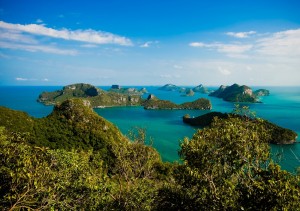China’s Island Disputes – A lot at Stake
Introduction
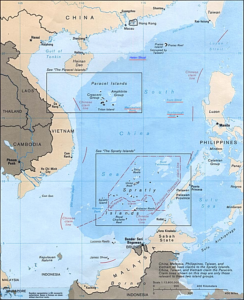
Map of the South China Sea
Among the numerous causes of friction between China and its neighbors, the continued failure to resolve a series of territorial disputes regarding islands in the East and South China Seas remains one of the most pressing. Threatening to destabilize the entire region, the disputed islands bring China into potential conflict with Vietnam, the Philippines, Malaysia and, most worryingly for regional security, Japan. Though virtually all the islands are uninhabited and largely uninhabitable, the islands carry with them issues of military strategic importance as well as access to a wealth of natural resources.
The East and South China Seas islands are not China’s only historical land disputes. China formerly had land-based territorial disputes with each of the fourteen countries with which it shares a border. However, it has worked hard to resolve these in a peaceful and frequently generous manner, accepting less than 50% of the disputed area in most cases. The only exceptions to this were with Russia, in which each side settled for precisely half of the disputed territory, and India, with whom several disputes are outstanding, complicated by the Tibet issue.
By contrast, almost no progress has been made towards resolution in any of the island disputes since the foundation of the PRC in 1949. Indeed, developments in recent years have seen a more assertive Chinese position causing serious friction and concern for regional stability. This seemingly belligerent stubbornness is rooted in a complex web of motivations that includes strategic considerations, access to natural resources and fish stocks, the psychological importance of national unification and territorial integrity, and a genuine sense of historical ownership.
Diaoyu/Senkaku Islands
One of China’s most talked about maritime dispute – certainly in recent times – is in the East China Sea, where it contends with Japan for the sovereignty of what it calls the Diaoyu islands, known to the Japanese as the Senkaku islands. The islands have occasionally been referred to in English as the Pinnacle Islands, but as this is a translation of the Japanese name it is normally not used unless expressing an opinion that the islands are Japanese territory. The rocky, uninhabited islands are located approximately 80 miles northeast of Taiwan and 250 miles west of Okinawa, an island over which there is no dispute and Japan’s most southerly prefecture. The five islands in the group have a total combined area of just 2.7 square miles and have no official residency or significant infrastructure. Nevertheless, although uninhabited, the islands remain important strategically. Not only are the waters surrounding the islands important for sea land control purposes given the amount of maritime traffic that passes through the area, but they are also important from the point of view of their fish stocks and their untapped hydrocarbon energy reserves. Additionally, from an international and domestic perspective, as each country claims sovereignty over the territory, it is hard for either nation to relinquish sovereignty rights without losing face and risking domestic political backlash. The dispute is complicated somewhat by Taiwan’s involvement, as it also claims the islands. However, this is not a challenge to China’s position as it considers the islands to be a part of the province of Taiwan, which is internationally recognized to be a part of China.
History
The islands are known to have been used by Chinese fishermen during the Ming Dynasty as shelter during storms, but were never permanently inhabited and their use by the Chinese appears to have come to an end at some time during the Qing Dynasty. Japanese historians argue that the islands were historically a part of the Ryukyu Kingdom, whose territory included a small chain of islands that Inc. Okinawa which operated as a relatively independent state until the late eighteenth century. However, there is evidence that shows the Ryukyu Kingdom itself acknowledged the islands to be a part of the Chinese realm, though this is disputed by some. By the time the Ryukyus were annexed by Japan in 1879 there was no mention of the Senkakus. The islands were re-discovered by a Japanese businessman named Koga in 1884, after which the Japanese surveyed the islands over a ten-year period, before fully incorporating them into Japanese administration in 1895.
Respective Positions
The Chinese position on the sovereignty of the islands has two bases: a historical claim; and a geographical claim. The historical claim refers to the first established use of the islands as outlined above. From this perspective, since the islands were first discovered and then used on a frequent basis by the Chinese as early as the 14th century, there can be no dispute as to the original sovereignty of the islands. Given their geographical location it is entirely logical that they would be a part of the province of Taiwan. However, this province was ceded to Japan in 1895 after the First Sino-Japanese War ended with the Treaty of Shimonoseki that awarded Taiwan to the Japanese “in perpetuity”. Taiwan remained a colony of Japan until its defeat in the Second World War in August 1945, at which point the Potsdam and Cairo Declarations – both accepted by Japan as conditions of its surrender – decreed that Japan should return Taiwan to Chinese sovereignty. As the Diaoyu Islands are considered to have historically been part of Taiwan, they should be included in this. The second basis of China’s claim is somewhat tenuous in international law and refers to the nature of the East Asian continental shelf. China claims that the shelf is part of Chinese territory and extends out into the East China Sea, incorporating the Diaoyu Islands. Though it is true that the continental shelf is exceptional in its extension, it is worth noting that such a claim has never been used by any other country in the world, and there is little to suggest that it has any basis in law.
The Japanese position on the islands is based on a claim of “continuous occupation or administration”. From the Japanese perspective the uninhabited and entirely undeveloped islands were rediscovered in 1884 by Koga, and an appropriate survey conducted over the following decade. They were then incorporated into Okinawa Prefecture as sovereign Japanese territory. After Japan’s surrender in August 1945, the islands remained under the administration of the occupying US forces, who maintained control of Okinawa until 1972, fully twenty years after handing back control of the Japanese mainland. For the Japanese, the Senkaku Islands were restored to Japanese sovereignty at this point and had not been separated from Okinawa Prefecture at any time since 1895.
Though China never acknowledged Japanese claims over the islands, it never challenged US administration of them during the almost three decades following the end of the war, though this is complicated by the presence on Taiwan of US allies the Kuomintang (Guomindang, KMT). However, it is notable that serious diplomatic noises surrounding the sovereignty issue only emerged after a UN report was released in 1968 suggesting that significant reserves of oil and gas may lie under the water surrounding the islands. Despite these noises, when the PRC and Japan normalized relations in 1972 the matter was shelved, as it was in 1978 during negotiations over the Treaty of Peace and Friendship, with Deng Xiaoping confidently declaring that “the next generation will be wiser”. Since then, no significant negotiation has taken place over the issue, with the Japanese exercising de facto control of the islands through regular patrols by the Japanese Coast Guard.
Modern Day Controversies
In response to Chinese claims over the islands, the Japan Youth Federation – a right wing group nationalist group with links to serious organized crime that seeks to promote a positive Japanese national identity and downplay Japan’s wartime atrocities – landed on the largest of the islands and erected a lighthouse, the first structure ever built on the islands. This was done without the consent of the Japanese government and China strongly objected to it as a provocation. The lighthouse has continued to be a source of controversy as members of the group have returned to the island periodically to conduct “maintenance”, frequently at times of increased tension over the issue. At the same time as building the lighthouse the group sought to address the problem of the islands being uninhabited, by leaving two (Japanese) goats behind. This symbolic gesture has had unintended but serious consequences for the island’s ecosystem; the single pair of goats, without any natural predators, has bred to a total in excess of 300, devastating the vegetation and bringing the Senkaku mole – an evolutionary distinct mammal found only on the island – to the brink of extinction.A diplomatic spat between China and Japan was sparked in 1996 when the Japan Youth Federation returned to the islands to conduct maintenance on its lighthouse. However, what is notable about the controversy is that it was not publicized in China until it had been resolved. The People’s Daily – the most widely circulated newspaper in China that also functions as the CCP’s mouthpiece – did not report on the issue, even in pieces that criticized Japan over other issues. There was a clear desire in China not to provoke the public over the issue, and the matter was dealt with relatively swiftly at the diplomatic level.
The issue continued to be one of several sources of tension between China and Japan throughout the rest of the 1990s and into the 2000s, without sparking serious incident. It remained a matter of dispute that was brought up during virtually every bilateral meeting and no solution has ever appeared close but neither side had sought to change the status quo. There were minor sources of irritation, including the arrest of a Chinese fisherman near the islands in 2004, but he was swiftly released without charge by the Japanese who sought to play down the significance of the incident.
However, in 2010, the matter returned to centre stage in Sino-Japanese tension. In September of that year a Chinese fishing boat was spotted in what Japan considers to be its waters. A patrolling Japan Coast Guard (JCG) ship ordered it to leave the waters immediately, but the fishing boat instead changed course to head directly towards the Japanese ship. Though the Chinese side later disputed this version of events a video taken from the JCG vessel that was later leaked by a disgruntled employee clearly showed that the fishing boat intentionally rammed into the Japanese boat twice. At this point the entire crew was arrested, sparking a major diplomatic dispute between the two countries.

Japan Coast Guard Vessel Yashima
Though the crew was released almost immediately, the captain of the boat was detained for a total of 17 days, on possible charges under Japanese law. The Chinese response was vociferous, both at the governmental and societal levels, with strongly worded diplomatic protests and apparently spontaneous street demonstrations against Japan. There were reports that China had suspended exports of rare earths to Japan in response, though academic analysis has later disputed this version of events. A group of Japanese businessmen were also arrested in the aftermath of the boat captain’s detention, on seemingly spurious charges that appeared to be a tit-for-tat retaliation. The diplomatic standoff finally came to an end when Japan apparently blinked first, with the Chief Prosecutor announcing the release of the captain without charge on the grounds of “Japan’s national interests”, something that caused a debate over the legality of the Chief Prosecutor’s actions within Japan. While this brought an end to this chapter of the dispute, it served to bring the islands to the forefront of Sino-Japanese tensions.
Japanese Nationalization
In 2012, Shintaro Ishihara, then the mayor of Tokyo and a right-wing firebrand who had long campaigned for a tougher policy towards China, launched a campaign to nationalize the islands. The three largest islands had been in private ownership since Japan integrated them into its territory at the end of the eighteenth century. The family that held the rights to them had been keen to sell them but was not willing to do so if there could be any threat to Japan’s sovereignty claims. As a result, Ishihara launched a bid to raise enough funds to buy the islands and vowed to take them under the umbrella of the Tokyo government. His plans also included the building of a harbor on the largest island, a move that would unquestionably have inflamed tensions with China and possibly have provoked a military response. When Ishihara’s campaign achieved its goal of raising sufficient funds, the national government decided it had no option but to move on the issue. The then-Prime Minister Yoshihiko Noda announced that the national government would purchase the islands and quickly struck an agreement with the family that owned them. This move was, without doubt, driven by a desire to lessen the tension with China as Ishihara’s plan was deemed highly provocative. Under the national government’s ownership, no development of the islands would occur and the status quo would effectively be maintained. Noda clearly hoped that this move would be recognized by the Chinese and the response would be proportionate.
However, the nationalization of the islands proved to be a particularly hot topic in China and the response from Chinese society was the most serious that has been seen in any international issue in living memory. A series of scathing diplomatic attacks from the government served as a backdrop to widespread anti-Japanese protests across China. In total, 85 cities on the mainland witnessed large protests with many of these becoming violent. Japanese businesses and citizens were harassed, with even the ambassador’s car coming under attack in Beijing. Calls for boycotts of Japanese produce – a common response from nationalistic Chinese whenever a dispute with Japan occurs – appeared to have a greater effect than ever; in one bizarre demonstration of support for this idea a man set fire to his own Honda car in the middle of a Shanghai street. The economic relationship was demonstrably affected, with Japanese firms temporarily closing factories in China and laying off tens of thousands of workers. Sino-Japanese trade had previously been thought to be almost immune to the repeated spats between the two countries, but annual trade dropped by 4% in 2012. Two-way tourism figures fared even worse, with Chinese visitors to Japan down 33% in October 2012 compared with the previous year while the numbers of Japanese visitors to China fell by two thirds in the second half of 2012.Since the nationalization China has stepped up “surveillance” of the areas surrounding the islands. Where once an unwritten agreement not to enter Japan’s de facto contiguous zone around the islands had kept the prospect of conflict to a bare minimum, China has since regularly flouted this norm. Though the incursions are frequently “Marine Surveillance” vessels rather than military ships, the possibility of conflict has been raised to its highest level since the two countries normalized relations in 1972. This was brought into sharp focus in December 2012 when a Chinese “Maritime Surveillance” plane entered the airspace of the islands, leading to the Japanese scrambling jets in response. A further escalation of the dispute in January 2013 occurred when the Japanese claimed that a Chinese PLAN frigate (a navy warship) had locked its radar onto a Japanese ship in the waters, suggesting that the first shots were about to be fired. Though China subsequently denied the incident, the fact that such ships are now in frequent and close contact has significantly raised the possibility of a miscalculation that might trigger actual armed conflict between the two powers. The seriousness of the situation is heightened by a declaration from Hilary Clinton in January 2013 that the US’ joint security treaty with Japan covers the islands, thus obliging it to defend Japan if attacked by China. This raises the possibility of direct conflict between China and the US for the first time since the Korean War and is a stark reminder to all involved of the gravity of the situation.
In October 2013 China declared an Air Defense Identification Zone (ADIZ) above the East China Sea, including directly above the islands. This requires aircraft entering the zone – which is separate from China’s territorial airspace – to identify themselves to the Chinese authorities, log a flight path and retain open communications for the duration of the period of time in the zone. Although the zone is not unique – several of China’s neighbors have similar zones, including Japan – the sudden declaration and the more stringent requirements imposed by China have made this a controversial move that is clearly linked to the islands dispute. Aircraft from both Japan and the US have so far ignored the rules without serious consequence but the potential for miscalculation has clearly been raised even further by this development.
South China Sea Disputes

In addition to China’s dispute with Japan in the East China Sea, it has competing claims with several countries of Southeast Asia for islands and maritime rights. China’s famous “nine dashed line” details its claim to virtually every single island and rock in the South China Sea, stretching to within 50 miles of the mainlands of Malaysia and the Philippines despite being more than a thousand miles from China’s mainland in several instances. There are two main groups of islands within this vast area of sea claimed by the PRC. The first is the Paracel Islands, which is disputed with Vietnam. The second is the Spratly Islands, which are wholly claimed by China, and which are partly claimed by each of Malaysia, the Philippines, Brunei, and Vietnam, with Indonesia also claiming maritime rights in the area without actually staking a claim to any territory. Additionally, there are disputes with the Philippines over Scarborough Shoal and Macclesfield Bank. As with the East China Sea, each of the disputes is complicated by matching claims from Taiwan which are based on the same justifications as the PRC.
The Paracels
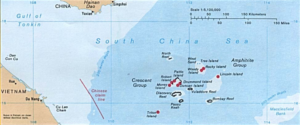
Known as Xisha Qundao (West Sand Islands) in Chinese and Hoàng Sa (Yellow Sand) in Vietnamese, the Paracel Islands are located approximately 200 miles south of Hainan Island (China’s most southerly province) and a similar distance east of central Vietnam. The group is made up of more than 30 islands, islets, reefs and sandbanks. Their significance lies mostly in access to significant fishing stocks, though it is thought that oil and gas deposits may also be present.
From a Vietnamese perspective, the islands have been sovereign territory since the 15th century, when harvesting of sea produce was conducted on the islands. This claim is supported by some historical evidence in the form of records kept by several of the Vietnamese dynasties that detail continual use of the islands throughout the following centuries. The islands were claimed by France in the mid-19th century after the colonization of Indochina, and this claim met with no objection from China. However, it is important to note that China was challenged politically at this time as it was facing the prospect of colonization itself for the first time in its history. The French reasserted their claim to the islands in 1930, this time meeting with resistance from what was then the Republic of China. The islands were annexed by Japan in 1939 as its military rolled across East Asia. Following Japan’s defeat in 1945, the status of the islands was left ambiguous by the post-War treaties, until Japan itself completed an agreement with Vietnam for the return of sovereignty over the islands 1952. Though this was complicated further by the partition of Vietnam two years later, the present-day reunified Vietnam considers this treaty to be valid and still in force, demonstrating its continued sovereignty over the islands.
China’s claims actually predate those of Vietnam, with record from the Song Dynasty suggesting that some Chinese habitation of the islands occurred during this time. The islands were also included in maps produced during later dynasties, including the Yuan and the Ming. Though the use of the islands appears to have subsided during the Qing Dynasty, no Chinese government ever renounced the claims and the Republic of China formally objected to the French colonial government of Indochina building a weather station on the largest of the islands in 1932. Additional evidence of China’s claim, perversely, comes from the Japanese invasion during the Second Sino-Japanese War, during which the Japanese foreign ministry demanded that France desist from activities on the islands on the basis that they were part of the administrative prefecture of Hainan Island, then under Japanese occupation. After Japan’s defeat, China considers sovereignty to have been returned to it under the terms of Japan’s surrender.
In 1974, while North Vietnam and South Vietnam were still engaged in war with each other for control of the two countries, the south fought a battle with China for the Paracel Islands. The battle was sparked by attempts from the South Vietnamese navy to expel Chinese fishing vessels from the surrounding waters, leading China to take military action in support of its fishing rights. After a brief naval battle and aerial bombardment, the Chinese forces launched an amphibious assault on several of the islands that it had not previously occupied, securing a decisive victory that established a permanent military presence on the islands. The battle lasted only a couple of days and Vietnamese casualties were relatively small, with around 50 deaths and a similar number of injuries, but the result was highly significant in the dispute over the islands as it established Chinese de facto control of the archipelago. A recurrence of military activity in 1988 left a further 70 Vietnamese dead, though this incident is frequently dismissed as nothing more than a ‘skirmish’.
The dispute remains unresolved and has been at the root of sporadic incidences of diplomatic difficulties between the two countries, usually sparked by disagreements over fishing rights. These spats have become more commonplace since China established a symbolic administrative region that incorporated the Paracels in 2007. In 2010 China announced plans to develop tourism to the islands in a move that the Vietnamese condemned as a “serious violation” of its sovereignty. A potentially serious flashpoint occurred in June 2011 when a Vietnamese oil survey ship was apparently rammed by a Chinese patrol vessel in waters close to Vietnam, seemingly outside of what even China considers to be its waters. Chinese military vessels have also detained Vietnamese fishermen on numerous occasions in recent years. For example, in March 2012 a total of 21 fishermen were arrested by Chinese patrol boats, after a fleet of around 100 Vietnamese boats entered what China considers to be its waters surrounding the islands. Though they were released a few weeks later the reaction sparked angry and violent protest against China in Vietnam, notably in the capital, Hanoi. Though both governments have sought to develop friendlier ties in many other areas of their relationship in recent years, the dispute over the islands remains a constant thorn in bilateral ties and a conduit for ugly nationalist sentiment in both countries.
In May 2014, China moved an oil rig from a part of the sea that was undisputed into an area that Vietnam considers to be its territorial waters. This sparked an angry response from both state and society in Vietnam with violent anti-Chinese protests breaking out across the country, resulting in several serious injuries to Chinese workers and the evacuation of hundreds of foreign workers (including many non-Chinese caught up in the protests). Though no direct military confrontation has followed, the dispute has taken Sino-Vietnamese relations to their lowest point for decades.
The Spratlys

Map of Spratly Island
The Spratly Islands are a group of around 750 islands, islets, reefs, and sand banks, totaling a little over one square mile of land but are actually spread out across in excess of 100,000 square miles of the South China Sea. They are largely uninhabited, but several countries have succeeded in establishing military presences on some of the islands in their respective claims. Thus, 45 of the islands are home to military forces from China, Taiwan, Vietnam, the Philippines, and Malaysia. Brunei also claims one island but has not established a military presence on it. China refers to the islands as Nansha Qundao (South Sand Islands) and considers them to be part of the same symbolic administrative region as the Paracels. It is the only country (except for Taiwan, whose own claims overlap the PRC’s for historical reasons) to claim the entire archipelago, which includes islands that are within 50 miles of the mainlands of Malaysia and the Philippines but more than 1000 miles from China’s own mainland. The economic value of the island is questionable at best, with initial surveys suggesting that oil and gas may be present but in unknown quantities. However, from a strategic perspective, as well as for reasons of national pride and for access to fishing stocks, the islands retain a high level of importance to all parties in the dispute.
As with the Paracels, China’s claims rests on historical usage of the islands during dynastic times, stretching back to the Yuan Dynasty, while Vietnamese claims are also rooted in their own historical use and supported by the French colonization of the area that purported to include the archipelago in its empire. Claims from Malaysia, the Philippines and Brunei are more geographical than historical, with each citing the proximity of uninhabited and undeveloped islands to their own undisputed sovereign territory as justification for their claims. The dispute is complicated by the lack of native populations and the previous colonization of several of the competing countries in the claims.
The dispute has remained unresolved and, particularly in recent years, has led to heightened tension with potential for military conflict in the region. Indeed, in May 2011 it was reported that vessels from the Chinese navy (PLAN) had fired upon several Vietnamese ships in the region, including two oil survey ships and at least one fishing boat. The incident contributed to a serious deterioration of ties between the two nations during that time and sparked further angry anti-China protests in major Vietnamese cities. Around the same time the Philippines government began to express concerns about China’s increased activity around the islands and openly warned the visiting Chinese Defense Minister, Liang Guanglie, that his country “risked sparking an arms race” in the region if China did not seek to ease tensions swiftly.
Scarborough Shoal and Macclesfield Bank
Outside of the Paracels and the Spratlys, the South China Sea is also home to Scarborough Shoal and Macclesfield Bank which are disputed between China and the Philippines. Both are significant for strategic reasons and for the implications that any acknowledged sovereignty claim might have on other disputes in the Spratly Islands.
Macclesfield Bank, known as Zhongsha Qundao (Central Sand Islands) is a completely submerged chain of reefs that does not qualify as territory under international law since it cannot be inhabited by human beings. Nevertheless, both the PRC and Taiwan claim it to be part of Chinese territory. The position of the Philippines government is less clear; in 2012 it objected to Chinese activity in the area but has never lodged a formal claim to sovereignty. In any case, since the atoll is entirely submerged it is not clear how such a claim would be made and what effect it could have.
Scarborough Shoal, known in Chinese as Nanyan Dao (South Cave Island) is actually a group of small islets or rocks, all uninhabited. Its sovereignty is disputed between China and the Philippines (as well as Taiwan) in the same way that the Spratly Islands are, though are considered geographically separate. Claims from all sides are somewhat patchy in their historical evidence, particularly as there is no evidence of inhabitation on any of the rocks at any point in history. Nevertheless, it remains a sore point in bilateral relations as both China and the Philippines seek access to fishing stocks and potentially other natural resources.
The dispute came to international attention in 2012 when eight Chinese fishing boats were apprehended by a Filipino naval vessel which accused the crews of illegally catching sharks and taking coral. China sent in two “Marine Surveillance” ships to block the Filipinos from taking further action and a standoff ensued, leading to heightened diplomatic tensions between the two countries and tit-for-tat protests in major cities. Strong winds ultimately led to the Philippines having to temporarily withdraw its presence, after which Chinese surveillance ships set up a naval blockade, preventing any further access to the shoal. Though no direct conflict occurred, the situation is ongoing with the blockade remaining in place to the chagrin of the Philippines.
China’s Construction of Artificial Islands in the South China Sea
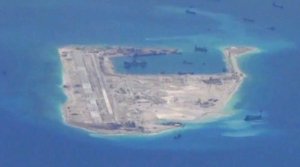 In 2014, China initiated dredging operations to build artificial islands around seven reefs near the Spratly Islands despite competing claims by Taiwan, Vietnam, the Philippines, and Malaysia. China is also building and fortifying an island on the strategic Scarborough Shoal, located 140 miles west of the large Philippine island of Luzon, and on Woody Island in the Paracels, located close to the Vietnam shore. By mid-2015, China’s land reclamation project had constructed almost 2000 acres of new land. On one artificial island built on Fiery Cross Reef near the Spratly Islands, China has built military barracks, weapon delivery systems, radar installations, jamming technology, lookout towers, and runways that have been used for the deployment of Chinese fighter jets. This military buildup is allowing China to significantly strengthen China’s anti-access/area-denial capacity and to increase its projection of force throughout the region. This projection includes an increase in the deployment of surveillance aircraft and guided-missile destroyer patrols as well as the actuation of radar, satellite, and other military surveillance equipment. These efforts have markedly increased China’s military presence in the South China Sea and significantly upgraded its peace and wartime positions. These islands are also creating facts on the ground which enable China to strengthen its de facto control over the water and the territory within its nine-dash line.
In 2014, China initiated dredging operations to build artificial islands around seven reefs near the Spratly Islands despite competing claims by Taiwan, Vietnam, the Philippines, and Malaysia. China is also building and fortifying an island on the strategic Scarborough Shoal, located 140 miles west of the large Philippine island of Luzon, and on Woody Island in the Paracels, located close to the Vietnam shore. By mid-2015, China’s land reclamation project had constructed almost 2000 acres of new land. On one artificial island built on Fiery Cross Reef near the Spratly Islands, China has built military barracks, weapon delivery systems, radar installations, jamming technology, lookout towers, and runways that have been used for the deployment of Chinese fighter jets. This military buildup is allowing China to significantly strengthen China’s anti-access/area-denial capacity and to increase its projection of force throughout the region. This projection includes an increase in the deployment of surveillance aircraft and guided-missile destroyer patrols as well as the actuation of radar, satellite, and other military surveillance equipment. These efforts have markedly increased China’s military presence in the South China Sea and significantly upgraded its peace and wartime positions. These islands are also creating facts on the ground which enable China to strengthen its de facto control over the water and the territory within its nine-dash line.
From this new position of power, China has become increasingly vociferous against the US and other national military patrols within the South China Sea waters, claiming that such patrols are in breach of its sovereign rights. Washington and its allies take the point of view that the South China Sea is not China’s exclusive sovereign waters, and therefore their navigation through the South China Sea is consistent with the freedom of navigation principle through these waters is still applicable.
Were the US and its Southeast Asian allies to forfeit complete dominion of the South China Sea to Beijing, they would be relinquishing their ability to effectively protect and monitor over approximately $5.3 trillion worth of shipping trade that travels through the sea each year, an estimated $1.2 trillion of which belongs to the United States. (Burgers, 2019) Southeast Asian claimants would also be ceding control of fishing stocks representing 10-12% (Kaplan, 2014) of the annual global catch. Currently, China consumes approximately 18% of the global marine catch, but this is expected to grow to 38% of the global marine catch by 2030. Southeast Asian claimants would also lose access to oil reserves estimated to be at 11 billion barrels and gas reserves estimated to equal 190 million cubic feet.
The South China Sea Tribunal
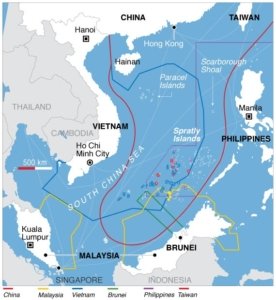 In 2013, the Philippines commenced an arbitral proceeding against China under articles 286 and 287 of United Nations Convention of the Law of the Sea. In its claims against China, the Philippines declared: that China’s nine dash line was invalid; that certain maritime features were claimed by both China and the Philippines; that China was unlawfully utilizing the living and nonliving resources in the Philippines’ exclusive economic zone and in the Philippines’ continental shelf; that the Philippines was being prohibited from reaping the benefits of said resources; that China had broken its responsibilities to protect and conserve the marine environment through its gathering of endangered marine species and coral as well as through the erection of artificial land features; and finally that China was unsafely maneuvering government vessels in a manner that was marring the navigation of Philippine vessels.
In 2013, the Philippines commenced an arbitral proceeding against China under articles 286 and 287 of United Nations Convention of the Law of the Sea. In its claims against China, the Philippines declared: that China’s nine dash line was invalid; that certain maritime features were claimed by both China and the Philippines; that China was unlawfully utilizing the living and nonliving resources in the Philippines’ exclusive economic zone and in the Philippines’ continental shelf; that the Philippines was being prohibited from reaping the benefits of said resources; that China had broken its responsibilities to protect and conserve the marine environment through its gathering of endangered marine species and coral as well as through the erection of artificial land features; and finally that China was unsafely maneuvering government vessels in a manner that was marring the navigation of Philippine vessels.
In 2016, an international tribunal in The Hague ruled in the Philippines favor. Specifically, the tribunal stated that the rocky outcrops claimed by China, some of which could only be seen during low tide, could not be the basis for China’s territorial claims; that China’s extensive claim to sovereignty over South China Sea waters as expressed by its nine dash line had no legal basis; that some of the waters claimed by China were well within the Philippines’ exclusive economic and that China could not use its artificial islands as a basis to claim rights over the Philippines exclusive economic zone; that its construction of artificial islands was illegal; and that China had breached the Philippines sovereign rights in those waters by obstructing Philippine fishing and petroleum exploration.
While the decision is legally binding, there is no mechanism for enforcing it. For China’s part, Beijing not only refused to participate in the tribunal’s proceedings, but it also stated that it would not abide by ithe Tribune’s decision. Since then, using the promise of economic reward being offered through China’s Belt and Road Initiative- which acts as both a political and economic initiative – China is using geoeconomic instruments such as loans, investment, and infrastructure development to blunt any impact of the ruling. For instance, China has leveraged the election of Philippine President Duarte to undermine the ruling’s impact. Specifically, China is working to negotiate an agreement with the Philippines to share oil and natural gas resources in the disputed waters. This agreement would be both a significant economic and policy victory for Beijing both by allowing it to share resources that were ruled to be exclusively Philippine but also by enabling it to potentially lock Western oil companies out of oil and gas development contracts in the region. It also sets a precedent for China that may ease the negotiation of similar agreements with other Southeast Asian countries.
In 2018, Brunei and China also announced that they would be exploring oil and gas resource extraction together. Part of Brunei’s motivation in agreeing to partner with China might be that the oil and gas reserves that have been the bedrock of its economy are projected to be depleted within the next several decades. Brunei’s oil and gas sector has historically accounted for approximately 60% of the country’s GDP and 95% of its exports. In anticipation, Brunei’s ruler, Sultan Hassanal, is seeking to diversify its economy and improve its domestic infrastructure while also seeking to identify new revenue sources. China’s Belt and Road initiative is providing the country with the technical, engineering and investment resources to help the country achieve its diversification objectives. The two countries are also creating the Brunei-Guangxi Economic Corridor as a mechanism to increase trade between the two countries. In 2017, China became Brunei’s largest source of imports, overtaking both Malaysia and Singapore. In return for this investment and economic aid, Brunei it is not only agreeing to develop offshore oil and gas resources with China, but it is also remaining quiet Beijing’s South China Sea claims, while not specifically relinquished its own claims publicly. It is also demurring to negotiate with China regarding the South China Sea claims through ASEAN multilateral mechanisms. This significant strengthens China’s negotiating position vis-à-vis the other Southeast Asian claimants. Divisions within ASEAN not only create ruptures between countries that Beijing can exploit, but it also gives Beijing further time to improve its de facto dominion over contested waterways. For its part, Beijing hopes to showcase Brunei as an example of the mutual benefits that can come from the mutual cooperation and joint development that is at the heart of China’s Belt and Road Initiative.
Trends
It is quite clear that an expansion of China’s naval capabilities achieved through its rapid military modernization has allowed China to become more assertive in its various maritime disputes with its neighbors. China’s more aggressive stand in the South China Sea represents a significant departure from the policy that China pursued when settling the various land disputes. This change of stance over the maritime disputes has had several implications for the region as a whole as well as for China itself.
Firstly, it has led to a worsening in bilateral ties with several of China’s neighbors. The most serious of these is the ongoing dispute with Japan. This has inflamed nationalist tensions on both sides. These nationalist tensions have left little room for compromise on this issue. Similarly, its relationship with Vietnam has also particularly suffered.
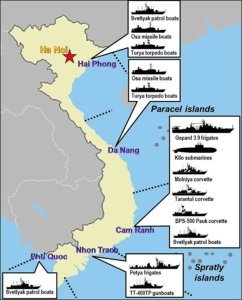 Secondly, many of China’s neighbors in the region are seeking individually and together to balance against China’s rise. This is evidenced first by the fact that defense spending in Asia is growing more rapidly than in any other region in the world. Specifically, it is estimated that between 2016 and 2020, the littoral states of South China Sea are expected to increase defense spending by 50%. There is also been an increase in joint military cooperation between many of the East and Southeast Asian countries including Japan, South Korea, Australia, India, and Vietnam, and with East and Southeast Asian countries and the United States. This growing Asian military spending and this increase in inter-Asian alliances reflects a recognition of a decreasing ability and willingness on the part of the United States to project its power within Asia.
Secondly, many of China’s neighbors in the region are seeking individually and together to balance against China’s rise. This is evidenced first by the fact that defense spending in Asia is growing more rapidly than in any other region in the world. Specifically, it is estimated that between 2016 and 2020, the littoral states of South China Sea are expected to increase defense spending by 50%. There is also been an increase in joint military cooperation between many of the East and Southeast Asian countries including Japan, South Korea, Australia, India, and Vietnam, and with East and Southeast Asian countries and the United States. This growing Asian military spending and this increase in inter-Asian alliances reflects a recognition of a decreasing ability and willingness on the part of the United States to project its power within Asia.
However, offsetting this greater military cooperation is the fact these countries have significantly increased their economic ties with China as their military cooperation has also risen. Additionally, Cambodia, Laos and Pakistan are not actively seeking to balance against China but are instead accepting the benefits that they are enjoying from a larger Chinese economic and military footprint. Going forward, increasing economic dependency on China means that East and South East Asian countries will be strongly motivated to maintain good relationships with Beijing even at the risk of some political and sovereign infringements. As China continues to roll out its Belt and Road Initiative, it can be expected that its economic ties to the region will continue to multiply over the next decades.
Strong economic ties between countries means that the cost of military confrontation is greater than it would be if countries share no economic bonds. Therefore, in addition to forming stronger alliances, many of these countries are seeking to maintain their sovereignty and autonomy by strengthening international norms and laws, promoting a rules-based order, and highlighting the importance of maintaining a Free and Open Indo-Pacific. Examples of these norms include freedom of navigation, peaceful dispute settlement, and support for the UN Convention on the Law of the Sea.
To the extent that this rule-based order undermines China’s political and economic objectives, China has indicated a willingness to ignore rulings or create divisions in multinational institutions. For instance, China has worked to create discord within ASEAN not because it fears a unified ASEAN’s economic and military strength, but because it does not want to appear as an outsider in the midst of regional consensus. Similarly, it is in China’s interest to undermine a coalition of smaller powers allied with the United States that might seek to contain China economically or strategically.
In the light of China’s more aggressive stance in the South China Sea, some of China’s Asian neighbors are also becoming more cautious regarding China’s Belt and Road Initiative. Some are wary to augment their economic vulnerability to China if they significantly increase the amount of money that they borrow from Beijing to implement infrastructure and other projects. Other Belt and Road Initiative concerns include losing sovereignty over parts of their territory due to extended leases granted to the Chinese as part of Belt and Road contracts. Concerns are also being raised regarding the secretive nature of many of these Belt and Road contracts and the lack of economic and environmental impact assessments that do not seem to accompany many of these projects. Finally, some expressed concerns about an increase of Chinese residents in their country that invariably seemed to accompany Belt and Road projects. It is expected that these concerns will become more vocal in the coming decade.
Thirdly, China’s hardline stance in the South China Sea is undermining its efforts to project an image of a responsible power in the region, where its rise can be counted on to be peaceful and not threatening. China counters this argument by stating that its claims to the South China Sea are indeed peaceful as the sea is and always has been Chinese territory; its greater military presence in the area reflects its desire to protect its territory from international encroachment. From China’s point of view, the South China Sea is China’s near abroad.
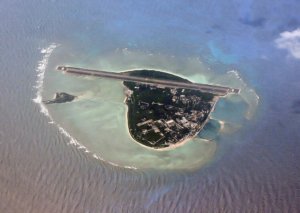 Finally, despite the costs to China’s international position and various bilateral relationships, its strategic and military position has been unquestionably strengthened in various parts of the South and East China Seas. It now controls, or has access to, several strategic positions that previously it did not. From a purely traditional military point of view, this can be viewed as a significant success and a gain in the balance of power in the region. China can be expected to consolidate these gains over the coming decade, all the while working to not antagonize the US or its Asian allies to the point of confrontation as it tightens its hold on the region. That said, China’s more aggressive stance increases the chance that confrontation could result from misstep or from misunderstanding.
Finally, despite the costs to China’s international position and various bilateral relationships, its strategic and military position has been unquestionably strengthened in various parts of the South and East China Seas. It now controls, or has access to, several strategic positions that previously it did not. From a purely traditional military point of view, this can be viewed as a significant success and a gain in the balance of power in the region. China can be expected to consolidate these gains over the coming decade, all the while working to not antagonize the US or its Asian allies to the point of confrontation as it tightens its hold on the region. That said, China’s more aggressive stance increases the chance that confrontation could result from misstep or from misunderstanding.

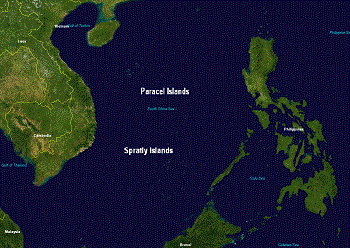

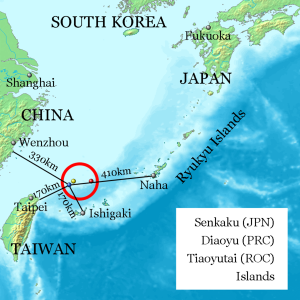
![By Wuyouyuan (Own work) [CC-BY-SA-3.0 (http://creativecommons.org/licenses/by-sa/3.0)], via Wikimedia Commons](https://chinafolio.com/wp-content/uploads/2013/03/Diaoyu_dao_quanjing_poster_IMG_1456A.jpg)
![By 中国海监总队/China Marine Surveillance (中国海监总队/China Marine Surveillance) [Public domain], via Wikimedia Commons](https://chinafolio.com/wp-content/uploads/2013/03/2012_China_anti-Japanese_demonstrations_in_Beijing-300x162.jpg)





